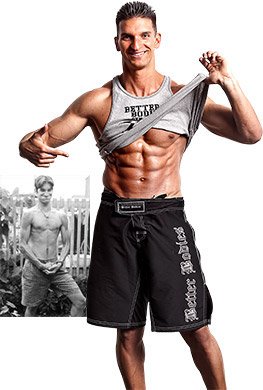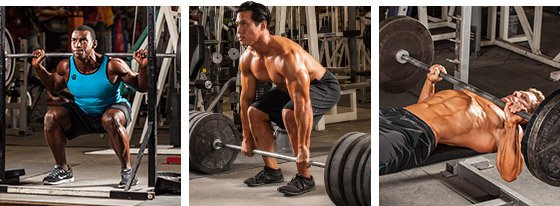I spent most of the first half of my life as a skinny guy, convinced I was genetically unfortunate when it came to building muscle. Since then, I've made a career of not only building my own physique, but helping thousands of other skinny guys do the same thing. You could say it's the part I was born to play.
Skinny guys are often referred to as "hardgainers" because it's assumed that we have to work out much harder and longer in order to see acceptable gains. However, what I've learned from my own experience, and from coaching and mentoring other former skinny guys, is that you don't necessarily have to work out harder. You just have to work out differently and strategically.
When Bodybuilding.com asked me to write an article that would help other skinny guys, especially guys who have been working out for less than a year, I knew right away that a simple workout plan wouldn't be enough. If it a simple plan was good enough, then everyone who Googled "mass-building workout" would succeed. And we all know that's not the case. Most skinny guys who have been working out for a year or less don't know how to pick or create a plan that will net them the best results.
This is why I decided to go a bit more in-depth with this article; to get past the "do this movement for X sets of X reps" hype and explain all of the key factors that will make the difference between an OK year with moderate gains, and an exceptional year that ends with 20, 30, or even 40 pounds of added muscle.
That's right, I said 40. It's possible! Understand, that by added muscle I mean lean muscle, not overall weight gain. I'm talking about 40 pounds of fat-free mass, made up of dry muscle, glycogen and water. I've seen it happen. Please send all your steroid jokes directly to the round file.
Experiencing the kind of gains that take other people 3-5 years of hard work isn't easy, though. You need the discipline of a soldier and the focus of a hawk. But follow these five steps, and you'll have what you need to blow the doors off of your wardrobe.
Step 1 Plan

You have no chance of adding 40 pounds of muscle in a year if you don't take the time to create a long-term plan. I'm not saying you need to have every month mapped out down to each rep and each meal—although, to be sure, that level of precision works wonders for some people. I'm saying that you have to have a list of attainable, track-able goals and a set of guidelines and variables that you plan to use to reach them. It's all about expectations and strategy beyond the next workout or the next month.
Think of it this way: If you're planning a cross-country road trip, you need to know where you are and where you want to end up before you start planning all the stops along the way. The same is true of bodybuilding.
To start, you need to know what your current body fat ratio is and what your measurements are. I would add that you also need to you know what your 1RM is with various big-money movements like the squat, deadlift, bench, and overhead press.
A coach or trainer can help you figure those out, if you're not sure how to do it on your own. Tracking your progress is essential, and to do that, knowing where you are right now is just as essential as where you're headed.
Speaking of coaches, I fully recommend you employ one in the beginning stages of your year. It could be a professional, either in person or online, or it could be just someone you know and trust who is willing to mentor you. And it doesn't have to be full year. Just a few weeks or months of qualified personalized instruction on things like form, training variables, and how to tweak your macros can be game-changing for beginners and advanced lifters alike.
I know that money can seem hard to shell out, given that there's such a profusion of free information out there. But just a little good instruction can help you get far more out of a free online program than you'd get by muddling through it on your own. And speaking from experience, the best gains of my life have always come when I worked alongside a coach; my slowest gains have always come when I went at it alone.
Step 2 Focus
Your overall goal is to gain 40 pounds of lean mass in a year—great! But be warned: Focus is absolutely essential to this kind of goal. You can't achieve anything this dramatic by going at it haphazardly or by jumping from one thing to another. Having the financial and social accountability of paying a coach or mentor can help with keeping you on track, but ultimately, you also need to learn to focus—really focus.

Focus on you
One of the worst things you can do as a new bodybuilder, and as a skinny guy, is to focus on the guys around you instead of on yourself. There's nothing wrong with admiring another guy's progress or physique, but when you start thinking you should be doing what he's doing or lifting what he's lifting, you're done. Trust your plan!
Focus on your priorities
Adding dozens of pounds of new flesh to your frame takes absolute commitment. It doesn't have to take over your life, but it does need to be a central focus. Sure, you might miss a workout because of a special event like a wedding and you might blow your diet a little at the wedding too. But after the big three of work, family commitments, and school, your plan should take priority.
That might mean giving up some of your favorite things to do, like hanging out with your friends every night, drinking beer, and eating pizza. It might mean going out one night each month instead of two times every week, or waking up at 6 a.m. instead of 8 a.m.
It may suck, and you may not see the point at first. But stay focused on the year. Fifty-two consecutive weeks that each has a few extra well-spent hours and a couple fewer bad decisions could make a big difference.
Focus on one goal at a time
Have you ever heard the expression, "Don't try to chase two rabbits at once?" It's one of my favorites when it comes to setting and reaching goals. You probably want several things at once. You want to lose 15 pounds of body fat, add six inches to your biceps, get a six-pack, and bench press 200 pounds.

Those are all decent goals, but you can't necessarily chase all of them at once. They all require different methods and different strategies. Chase all of them or even two of them at once and you'll end with none of them. Chase one rabbit at a time and get it in the cage before you turn to the next one.
Of course it's OK to have supplemental goals. They're fantastic at helping you mark each leg of your journey to big gains. Just make sure that your supplemental goals don't compete with your primary goal. Focus on one goal at a time which dovetails with the project of mass-building, and don't move on until you achieve it.
Step 3 Do the Work
If there's one word that I think is the most valuable when it comes to your actual workouts, it's variation. It's hands-down the most powerful tool for growth that you will ever utilize. Variation keeps your metabolism and your central nervous system on their respective toes and allows you to take advantage of the transition period between one thing and another, which is when you will see the most gains in strength and growth.
However, when I say variation, I don't mean changing from one plan to another without knowing why, or because you're bored, or because you heard that Plan X is the best thing ever. When I say variation, I mean something far more systematic. Here are some examples:

Spark Your Muscles Into Growth
Some people will tell you growth is all about volume, volume, volume. But if that's not working for you, increase the intensity and do more with less!
Earn your volume
One thing I firmly believe is that new bodybuilders need to earn increased volume as they go. Here is an example of how you could map out the structure of your program for the next 12 months:
- Months 0-3: Full-body workouts
- Months 4-6: 2-day splits (ex: upper body/lower body)
- Months 7-9: 3-day splits (ex: push/pull/legs, or the high-intensity skinny guy workout)
- Months 10-12: 4-day splits (ex: chest and calves/legs/shoulders and tris/back and bis)
Bulk in cycles
I'm a longtime advocate of cyclical bulking, in periods lasting as short as just a few weeks. It's become something of a trademark of my programs for skinny guys, like the 21-day Mass-Building System. The thing about cyclical bulking is that when you use shorter bulking and cutting phases, you're able to take advantage of that transitional phase between bulking and cutting, when your metabolism and anabolic hormones are completely revved up, and then switch it out again before your body adapts and you hit a plateau.
When you go from bulking to cutting, you're able to take advantage of improved insulin sensitivity but then you switch back to bulking and take advantage of all those anabolic hormones that were stimulated by your reduced calorie intake. You go back and forth before your body has a chance to adapt to either phase.
One of the many advantages of this is that you don't have all the fat gain that comes with traditional, longer bulking phases of 4-6 months, and you don't have all the misery and muscle catabolism that comes with longer cutting phases.
Having said that, don't be afraid to bulk up during this first year. You're skinny and you can take a little extra fat. You'll torch it off soon enough, so it's OK to overshoot your weight gain goals by about 20 percent before you move on to a cutting phase.
Manipulate the variables
Learn to use all of the variables in your workout. Play with shorter rest periods, longer time under tension, and other small-scale changes. Changing these can help you increase the intensity and effectiveness of your workouts, so that you don't end up dumping a routine altogether before it's had time to do its job.
Step 4 Eat (and Cook!)
Nutrition is more than half the game when it comes to building muscle. You won't gain much muscle on even the best program if your calories and macros are off, you're deficient in crucial vitamins and minerals, and your digestive system is out of whack.
Here are the simplest, most effective ways I've found to get your nutritional life in order.
Know and adjust your macros
Too many people take "bulking" as an excuse to get sloppy in their eating. On the contrary, this is an opportunity to learn and apply the fundamentals of good nutrition. Educate yourself on how to calculate your current macronutrient intake, and remember that they'll change as you grow and depending on whether you're bulking or cutting. If your progress begins to slow, your macros are the first place to look for an answer.

Clean up your diet
You can't build solid muscle out of garbage. Sorry, that's just the truth. It doesn't matter how hard you work in the gym; if you still eat a nutrient-poor diet, your body will reflect it. Get all of the processed foods out of the house and watch your intake of flours, sugars, and unhealthy fats ruthlessly. If your insulin and blood sugar levels are completely out of balance it will make it virtually impossible to gain anything other than fat.
Start juicing
One of the best things I've done nutritionally in recent years was to start making juices at home with fresh fruits and vegetables. Juicing loads your body up with micronutrients in seconds, speeds up your metabolism, cleans out your digestive system, and boosts your immunity.
Over time, these nutritional blasts can help reduce inflammation and get your hormones back on track. They also offer more acute benefits, like helping relieve muscle soreness and improving recovery after hard training.
Juicing to Relieve Muscle Soreness
Watch The Video - 10:25
Cook
I recently spent time learning how to cook from a professional chef, and the experience was a game-changer for me. I learned how to make my food taste better and waste less of what I buy, all while saving loads of time. Now I prepare a whole day's worth of meals at once, so I have healthy meals and snacks ready whenever I need them.
This not only keeps me from eating unhealthy food but also ensures that I get a wide variety of whole foods that I actually look forward to eating. This made such an impact on my gains and my energy levels that I've devoted the whole current season of my online series Live Large TV to preparing meals in bulk.
Step 5 Rest
If you asked me what one factor of gaining muscle is most underrated, I would say rest. This is especially true of skinny guys who are so anxious to see change that they try to pack two years of work into one. A lack of rest will stomp the brakes on gains faster than you can believe—and I'm talking about both sleep and physical rest, or deloading. Here's what you need to keep in mind about both.
Daily Rest

If you're not getting at least seven—preferably eight—hours of sleep every night, you're almost assuredly not going to reach your goal of 40 pounds in 12 months. There are a couple of reasons for this.
First, nearly all muscle recovery takes place while you sleep, and it happens primarily during rapid-eye movement (REM) sleep. REM normally doesn't begin until six hours after you fall asleep, so if you only sleep six hours per night, you're not going to see the muscle growth that you should. Without adequate recovery time, you'll break muscle down faster than you repair it.
Second, sleeping less than eight hours per night has been shown to raise cortisol levels and also throw levels of the appetite-regulating hormones leptin and ghrelin out of balance.
This means your body will be stimulated to store calories as fat instead of turning them into glycogen and sending them to your muscles.
Periodic Rest or Deloading
Giving your body a break from intense training is just as important as getting adequate sleep each night. If you don't step back periodically, you'll burn out your central nervous system and throw your hormones out of whack.
For many skinny guys on a long-term gaining plan, I advocate four months of bulking, followed by one week of cutting, and then a solid week off before repeating the cycle. This resets your hormones, particularly your insulin levels, so that when you go back to your workouts your body is absolutely primed for gains in both strength and size. Even if you skip cutting, take that week of rest at least every 12 weeks.
You don't necessarily have to lie on the couch for a week. Some guys—including myself—take the week off altogether. Other guys are happier if they spend the week doing a much less intense workout, or just cut the volume in half for each workout but maintain their normal weights.
Other guys work out twice per week during a deload instead of every day. The point is to give your muscles and your CNS a break from what you have been doing. I promise that when you get back to your regular routine or start a new one, you will see serious results.
Take Aim At Gains!
Now that I've shared some of the key principles to seeing 40 pound gains in one year, I want to leave you with the best advice I know for reaching and surpassing your goals: Use rifle bullets, not shotgun shells.

When tracking your progress and tweaking your program, think like a sharpshooter picking his weapon. With a shotgun, you aim in a general direction and hope to hit something. With a rifle, you've got your eye focused right on the target and you take careful aim. Guess which one gets more consistent results?
For instance, if your gains are slowing or you feel hungry all the time, don't say "I need to increase my protein, so I'll try to eat more chicken and see how that goes." How do you measure the success or failure of that? Instead, say "I'm going to go from 1g of protein per pound of body weight to 1.5g per pound, and see what that does over two weeks time."
Every goal, every change, and every new idea should have measurable data in terms of pounds lost, carbs eaten, kilos curled, days worked, seconds rested. If you don't measure it, you can't track and evaluate it, and you can't strategically plan your next move.
Setting goals, following the plan, and paying attention to every step along the way is essential to reaching your goal of adding 40 pounds of lean muscle over the next 12 months. I know what it takes to transform a skinny guy into a muscle machine, so let's do this!

